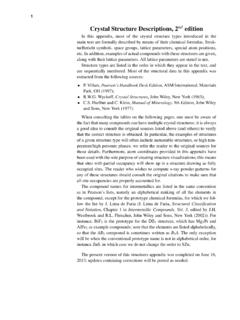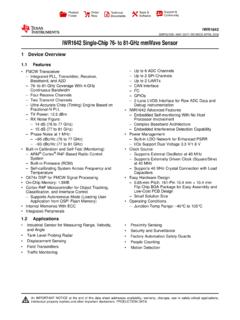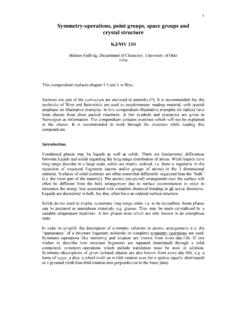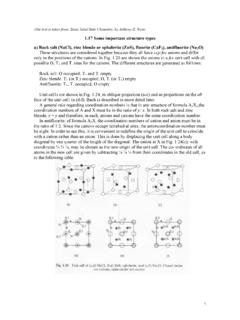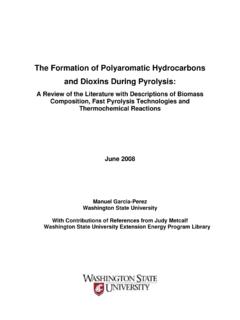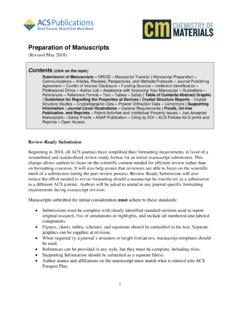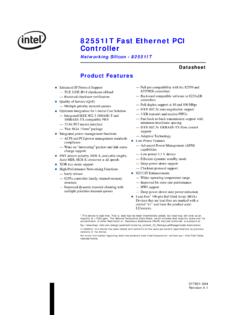Transcription of Log ASCII Standard Document #1 – File Structures
1 LAS Log ASCII Standard Document #1 File Structures Kenneth Heslop - Oakrock Ltd., Calgary (Committee Chairman). Jim Karst - Schlumberger GeoQuest, Calgary Stephen Prensky - SPE, Consultant, Silver Spring, MD. Dennis Schmitt - Texaco Upstream Technology, Houston Release June 6, 2000. Table of Contents LAS Ver Discussion 4. What's new in LAS Ver 5. Conventions Used in this Document . 6. Major Components of a LAS Ver File 7. Primary Section Types 7. Parameter Data Sections 7. Column Definition Sections 7. Column Data Sections 7. User Defined Sections 7. Lines Within Sections 7. Parameter Data Lines 7. Column Definition Lines 8. Column Data Lines 8. structure Details 9. Sections 9. Lines within Sections 9. Section Title Lines 9. Parameter Data Lines 10. Column Definition Lines 11. Column Data Lines 11. Individual Section Descriptions 13. Required sections 13. ~Version section 13. Required Contents (All files) 13. Details Specific to the ~Version section 13.
2 ~Well section 14. Required Contents (All files) 14. Details Specific to the ~Well section 15. Data Section Sets 17. Log Data sections 17. Core Data sections 18. Inclinometry Data sections 19. Drilling Data sections 20. Tops Data sections 21. Test Data sections 22. LAS Data Formats 23. Floating Point 23. Integer 23. String 23. Exponential 24. Date and Time 24. Degree Minute Seconds 24. Three Dimension Data Arrays in Column Data sections 25. Section Title Arrays 27. Parameter Data Line Arrays 27. Associations in LAS 28. Example 1. Storing Multiple Runs 28. Example 2. Column Data Channel Matrix Identification 29. LAS File structure Specifications -- Page # 2. Example 3. Parameter Zoning 29. Column Data and Column Definition Section Associations 30. Adding User Defined Data and Sections 31. Appendix I Example LAS Ver file 32. Appendix II LAS Ver Restricted Characters and Words 36. Characters 36. Section Titles 37. Parameter and Definition section Mnemonics 37.
3 Appendix III Definitions 39. Appendix IV Termination Issues 41. Appendix V Real Time Data Acquisition 42. Appendix VI LAS Certify 43. LAS File structure Specifications -- Page # 3. LAS Version Discussion The LAS format began with the desire for a simple format to exchange well log data. The world-wide acceptance of LAS proved the need for such a format. As users embraced the concept and the format, many new applications of the concept were attempted. As data users, we have all been tempted to put more data into our LAS files than the format was originally designed to handle. This led to the realization that LAS needed to expand. LAS was originally proposed as an update to LAS , with just minor changes to handle more well log data, such as multiple logging runs. But, like a ball rolling down a hill, the process quickly gained speed. What we are now presenting is a major redesign of the LAS format. We have maintained the founding principles of LAS, and those using LAS for log data alone will find that the format is much the same as previous versions.
4 However, those wishing to use LAS for other data types will find in this format the expanded flexibility to accurately and completely describe their data. Originally LAS was designed around a collection of file sections . Each section began with a title line, and that title line was marked with a tilde ( ~ ) at the beginning of the line. This design has been maintained, and we have added several new sections, plus added the rules for adding user-defined sections. The Standard will be released in two major parts. This first part will describe the file Structures , including those defined to hold the new data types, and the details of how to build a LAS ver file. The next part of the LAS release will describe specific CONTENT requirements. These content requirements will describe the exact sections, parameters, and channels that will satisfy the specific needs of each group or organization that wishes to define a LAS content requirements. To introduce the new structure concepts, remember that in previous versions of LAS the following sections were required: ~Version, ~Well, ~Curve and ~ ASCII .
5 The ~Version section contains only data related to the LAS file. This section is still required in LAS , and now has additional options added. The ~Well section contains all data that is common to every data set related to that specific well, including the well identification and location. This section has been maintained and expanded. The remaining sections in an LAS file will be defined by the data set or sets being included. In general terms they will follow the pattern of a Parameter section, Definition section, and a Data section for each data set. This is consistent with the historical ~Parameter, ~Curve and ~ ASCII sections used for log data. While these section names have been maintained for log data, the equivalent sections for new data sets will follow this new naming convention: ~Section_Parameter, ~Section_Definition, and ~Section_Data. Some data sets will require all three of these section, others may only require a Parameter section, or a combination of Definition and Data sections.
6 A LAS file might contain just one data set, such as logs or core, or it could contain a number of data sets. Whichever option is chosen, there must only be one ~Version section, and one ~Well section. These sections must also be the first two sections in the file, and in this order. After that, each data set should appear as a set. For example, the ~Parameter, ~Curve, and ~ ASCII sections must appear together. Likewise ~Core_Parameter, ~Core_Definition, and ~Core_Data must appear together. The future has been designed into the new version of LAS. Using the following two data models, provision has been made to allow users to define new sections as the need arises. These new sections should fit either of the following cases: 1) Self-contained Sections, such as the ~Well Information and ~Parameter sections. (Note: In most cases the ~Parameter sections are related to other data sections.). Following this example, the new section would look something like this: ~NewSection_Parameter LAS File structure Specifications -- Page # 4.
7 Name .Unit Data : Description {F} | Association 2) Data Sections with related Definition and optional Parameter sections. These sections will follow the ~Parameter, ~Curve, ~ ASCII model where ~Parameters contains header information related to the log data, ~Curve contains the definitions of the log curves present, and ~ ASCII contains an indexed table of log digits. ~NewSection_Parameter Para1 .Unit Data : Description {F} | Association ~NewSection_Definition Index .Unit Data : Description {F} | Association Chan1 .Unit Data : Description {F} | Association ~NewSection_Data | NewSection_Definition , , , The Parameter sections are optional, and should only be used for data that is directly relevant to the type of data intended for that section. In all cases, user-defined sections must follow the same structure rules set out for the defined sections in this Document . What's new in LAS Ver This is a short list of the new features in Ver 1. New Data types.
8 (Core, Drilling etc). 2. " structure " rules separated from "Content" rules. 3. New delimiters and Structures . 4. Comma Tab and Space delimited data. 5. Handles 1D, 2D and 3D arrays 6. Supports Multiple Runs. 7. Parameter Zoning. 8. Floating point, string, integer, Date and Time formats supported. 9. Addition of User defined data is easy 10. WRAP YES has been dropped. 11. ~Other section has been dropped. LAS File structure Specifications -- Page # 5. Conventions Used in this Document . If it looks like this; It means this: Text that appears in this non-proportional font : Bit Size style indicates example text that is an excerpt from a LAS file. Text that appears in this non-proportional font with the wavy underline is an example LAS. BS . IN | ; Bit Size {F} content that violates the LAS Standard in some way. This is used in examples to illustrate common errors. Text that appears in this font style is a LAS Parameter Data related term defined in the LAS Document .
9 A. definition for these phrases can be found in Appendix III. Text that appears in this Italics style of this non- proportional font style indicates a placeholder for BS .Unit Value : Description the actual file contents that would appear in that position, defined by the word in italics. In this example the file would contain an actual unit for BS, such as INCH, not the word Unit. LAS File structure Specifications -- Page # 6. Major Components of a LAS Ver File LAS Files are divided into logical sections. Sections are recognized by lines that begin with the ~ (tilde, ASCII 126) character. These section defining lines are called Section Title lines. Specific sections are recognized by their names, which follow the ~(tilde). character. The entire word following the ~ is the section name, not just the first character after the ~. Sections contain lines where data is described and/or stored. There are several types of sections and several types of lines within sections.
10 The LAS Standard defines which combinations of sections must exist in LAS files, and in which order. For example, the ~Version and ~Well section must exist in that order in all Ver LAS files. As in LAS version , only one well will be described within a single file. Data is stored as one, two or three dimensional arrays. The data are usually indexed to depth or time, but may be presented as discrete measurements if required. Data is grouped by type into related sections, as they relate to the well in which that data was acquired. Types include depth and time indexed Logging, Core, Inclinometry, Drilling, Formation tops, test data, user defined types, etc. Primary Section Types Parameter Data Sections Contains any number of Parameter Data lines (see below). Intended to hold One dimensional data that relates in general to one of the data types described. Column Definition Sections Contains any number of Column Definition lines (see below). Intended to hold detailed descriptions (name, unit, etc) of each 2D or 3D channels stored in a Column Data section.
